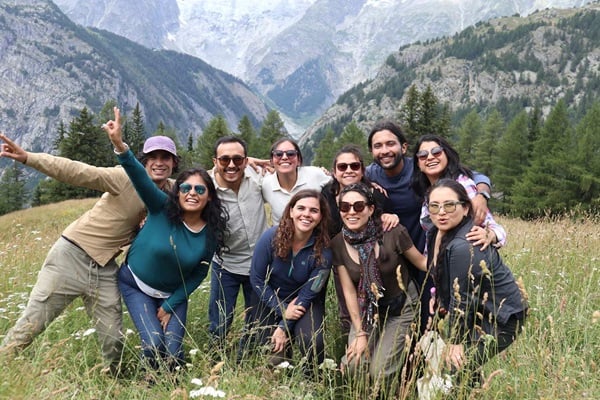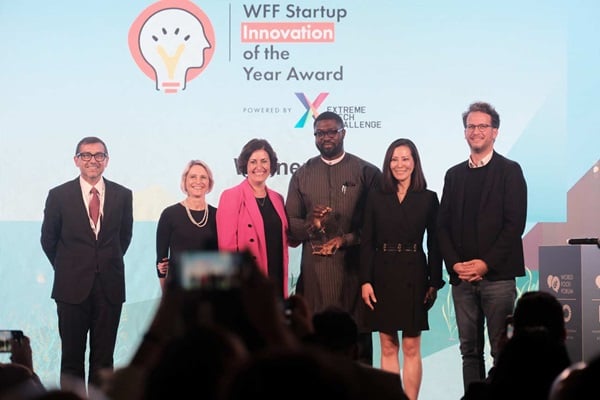2021 Foodicons of the year
An oft-cited challenge facing global agri-food systems is the lack of a common language. To address this, Foodicons and the World Food Forum (WFF) have announced
the first-ever selection of key terms that describe global food systems with their announcement of “2021’s Foodicon of the Year”.
These terms capture the past year’s discussion and zeitgeist surrounding global food
systems and food-related issues. This was a landmark year for raising the prominence of the challenges and threats facing global agri-food systems, highlighting the growing need for better communication and collaboration that a visual language like
Foodicons can support. The winner is:
![]() Agri-food systems
Agri-food systems
Our multidimensional agri-food systems provide food, feed, and fodder; the use of this phrase by the Food and Agriculture Organization of the United Nations (FAO) and WFF has increased dramatically throughout the year. "We have to feed 2 billion more people by 2050 and save the only planet we have. This is possible only if we look at the agri-food systems holistically and consider all the elements and their relationships," said Máximo Torero, Chief Economist of FAO.
This icon, by encompassing the entire journey of food from farm to table — including when it is grown, harvested, processed, packaged, transported, distributed, traded, bought, prepared, eaten, and disposed of, helps to introduce the complex challenges we all face in creating a more sustainable food system. The official definition can be found here.
Foodicons was originally developed by The Lexicon’s Green Brown Blue accelerator program and is now an initiative of the WFF, a youth-led movement to drive agri-food systems transformation initiated by FAO’s Youth Committee. “When consumers have a deeper understanding of the food they eat, they can better support agri-food systems aligned with their values,” notes The Lexicon’s Douglas Gayeton.
Runners-up for Foodicon of the Year were terms and principles well known among agri-food experts yet with limited visibility among the wider public. Their selection as Foodicons of the Year can help raise awareness and literacy surrounding some of the most pressing issues and challenges that our agri-food systems face:
![]() Food security. Captured in the United Nations’ Sustainable Development Goal (SDG) 2 (Zero Hunger), achieving food security will mean that at all times, people have physical and economic access
to sufficient, safe, and nutritious food that meets their dietary needs and food preferences. In 2021, the number of people facing hunger increased to 811 million.
Food security. Captured in the United Nations’ Sustainable Development Goal (SDG) 2 (Zero Hunger), achieving food security will mean that at all times, people have physical and economic access
to sufficient, safe, and nutritious food that meets their dietary needs and food preferences. In 2021, the number of people facing hunger increased to 811 million.
“Sharing this concept through Foodicons, as well as its importance and its real impact, can help to attract more and more people, organizations, companies, and initiatives seeking to support and join in a future with food security for all.” — Yazú Romero, food scientist on the Foodicons Global Team
![]() Regenerative agriculture. By focusing on conserving land, soil, and biodiversity, regenerative agriculture focuses on the regeneration of agroecosystems to achieve food and nutritional security with economically and environmentally
sustainable options.
Regenerative agriculture. By focusing on conserving land, soil, and biodiversity, regenerative agriculture focuses on the regeneration of agroecosystems to achieve food and nutritional security with economically and environmentally
sustainable options.
“Many of these concepts are consistently replicated in different parts of the world. To create collaboration, synchronicity, and global understanding we need to go beyond linguistic differences and find a graphic common code. The Foodicons Challenge tackled this urgent need and produced an amazing collection of icons representing key concepts of regenerative agriculture.” — Pablo Munoz Ledo, REGEN1
![]() Food waste. Food waste (and loss) are significant contributors to global warming and agri-food systems
inefficiencies and an estimated 17% of the food available to consumers is wasted. Tackling loss and waste
can deliver a triple win by feeding more people with healthier diets, generating income for agri-food systems workers, and conserving natural resources.
Food waste. Food waste (and loss) are significant contributors to global warming and agri-food systems
inefficiencies and an estimated 17% of the food available to consumers is wasted. Tackling loss and waste
can deliver a triple win by feeding more people with healthier diets, generating income for agri-food systems workers, and conserving natural resources.
“Food waste implies throwing away all of the inputs required to grow our edibles: water, energy, labor. We cannot allow this to continue or we won't be able to feed more than 9 billion people by 2050. Foodicons have the potential to stop this issue by providing people with simple strategies to avoid food waste: best storage practices, creating new meals from leftovers, and well-planned grocery shopping.” — Ana Cristina Vides, food scientist and Thought for Food Ambassador on the Foodicons Global Team
![]() Agrobiodiversity. Agrobiodiversity is the wealth of plants, animals, and microbes that make up
agricultural systems and can be used to tackle challenges like malnutrition, climate change, and environmental degradation. A study found that after reviewing hundreds of primary literature sources that examined potential crop diversity loss, almost 80% found evidence of loss. Foodicons for terms about agrobiodiversity was
featured at the 2nd International Biodiversity Congress November 15-18, 2021.
Agrobiodiversity. Agrobiodiversity is the wealth of plants, animals, and microbes that make up
agricultural systems and can be used to tackle challenges like malnutrition, climate change, and environmental degradation. A study found that after reviewing hundreds of primary literature sources that examined potential crop diversity loss, almost 80% found evidence of loss. Foodicons for terms about agrobiodiversity was
featured at the 2nd International Biodiversity Congress November 15-18, 2021.
"So why use neglected and underutilized species? These represent an opportunity to address all those different aspects (climate change, biodiversity loss, environmental degradation, and malnutrition), but also more. It’s because they also preserve and diversify the cultural and relevant nutritional sources.” — Dr. Carlo Fadda, Director of Biodiversity for Food and Agriculture in the Alliance of Bioversity International and CIAT
![]() Climate-smart agriculture. By guiding agri-food systems toward green and climate-resilient
practices, climate-smart agriculture supports the SDGs and the FAO Strategic Framework based on the Four Betters: better production, better nutrition, a better environment, and a better life for all. This will be even more critical to mitigate the
increasing impact of climate change and feed the world’s 10 billion people by 2050.
Climate-smart agriculture. By guiding agri-food systems toward green and climate-resilient
practices, climate-smart agriculture supports the SDGs and the FAO Strategic Framework based on the Four Betters: better production, better nutrition, a better environment, and a better life for all. This will be even more critical to mitigate the
increasing impact of climate change and feed the world’s 10 billion people by 2050.
"Climate smart agriculture encompases complex social, environmental and technical elements. It is for this reason that Foodicons’ effort to create a visual language and open and accessible tool kit is so important to communicate local nuance of systems level concepts and meaning across global geographies, cultures, and production systems." — Dorn Cox, Research Director at OpenTEAM
Foodicons — is a respected, validated, and imminently useful universal visual language to describe our agri-food systems. Born from an unprecedented global collaboration between hundreds of designers and agri-food system experts, Foodicons contains visual representations of foundational terms and concepts in key thematic areas, from nutrition to food security, food waste to regenerative agriculture. This open-source collection is made freely available as a Public Domain resource for use by international NGOs, food companies large and small, as well as government agencies.
Through this multi-stakeholder initiative, domain experts and the general public will be provided with an easy-to-use set of communication tools that leverage FAO areas of editorial and scientific expertise. The initiative will also help FAO engage and align partners and relevant academic networks, and help FAO play a critical role in providing visual support for documents, statements, and action-oriented FAO initiatives. Finally, Foodicons will actively focus on creating communication tools in tandem with the World Food Forum that activate youth action, innovation, and education.
The World Food Forum (WFF) – powered by global youth, is an independent global network of partners, created for and led by youth, to spark a movement to transform our agri-food systems and achieve the Sustainable Development Goals, including “Zero Hunger”. The WFF serves as an ongoing platform to engage and harness the passion of youth to identify solutions and galvanize action to address the growing challenges facing our agri-food systems.
The Lexicon — directs Green Brown Blue, an accelerator for good ideas. The NGO works in collaboration with government agencies, universities, foundations, television networks, publishers, non-profits, community organizers, and sustainability advocates from around the world. By illuminating the meaning behind complex ideas, the organization helps people pay closer attention to how they eat, what they buy, and where their responsibility begins for creating a healthier, safer agri-food system.



-2023-winners.tmb-th600x400.jpg?Culture=en&sfvrsn=3e5d4076_1)